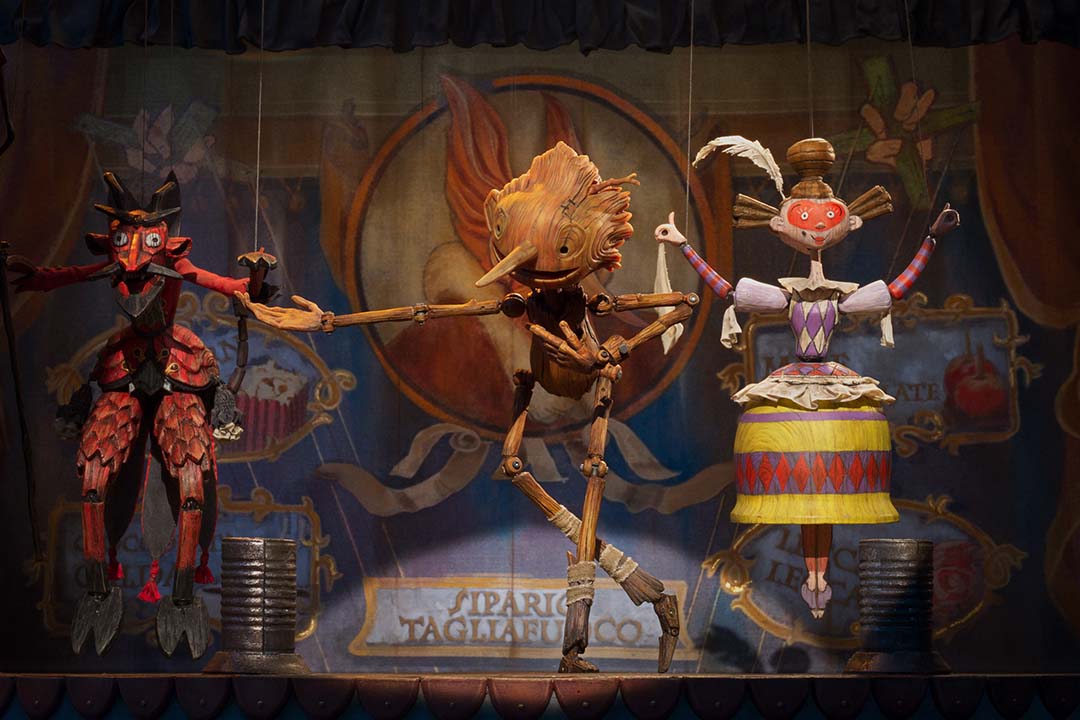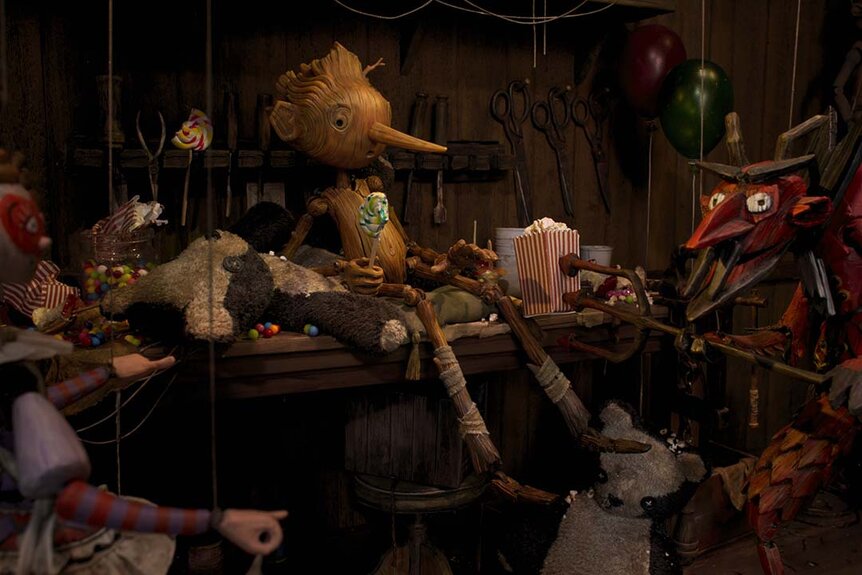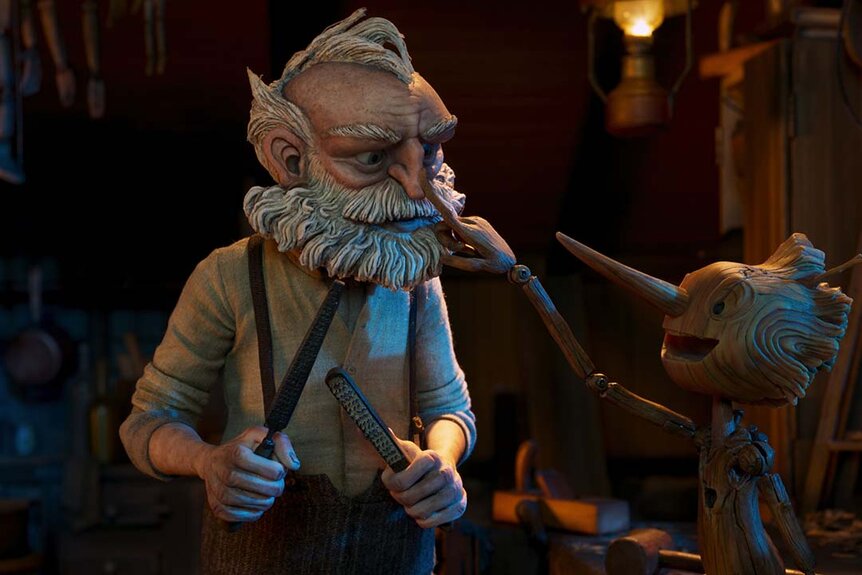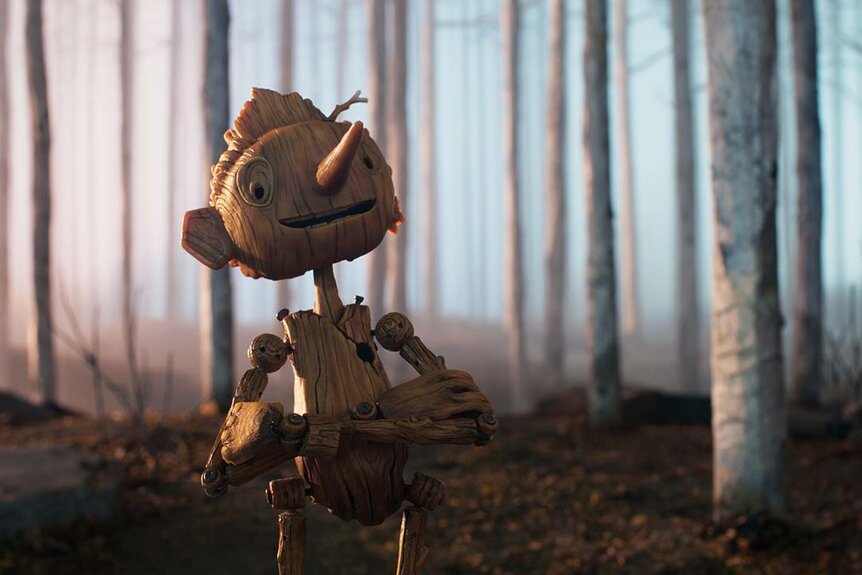Create a free profile to get unlimited access to exclusive videos, sweepstakes, and more!
Guillermo del Toro's 'Pinocchio' used walnuts and guitar wood to reflect the puppet's 'massive arc'
"Pinocchio, at any given time, is made up of eight different sounds."

Scott Martin Gershin's professional relationship with Guillermo del Toro goes back 20 years. The veteran sound designer/supervisor has worked on bringing the sonic side of the director's fantastical visions to life since 2002, working on films like Blade II, Hellboy II: The Golden Army, Pacific Rim, and the TV series The Strain. But, even after playing in these epic sandboxes of vampires, demons, and kaiju for so many years, nothing could have prepared Gershin for del Toro's stop-motion take on Pinocchio (now streaming on Netflix).
"A lot of [those projects] were weird, loud, and in-your-face," he tells SYFY WIRE. "I always wanted to work on Guillermo’s more subtle shows. And he said, ‘This is not heavy metal, this is minimalistic jazz.' So for me, it was all about trying to figure out 'when’s it my time to play my part?’ and then pull back and have that mastery of knowing when to engage and when not to. That was always at the forefront of the design and the approach to this show."
Helmed in conjunction with stop-motion maven, Mark Gustafson (Fantastic Mr. Fox), the ambitious and masterful feature is about as far removed from the Disney version as one can get. For one thing, it adheres much closer to the 19th-century source material written by Carlo Collodi. For another, its visual style is based on the macabre — and rather mischievous — Pinocchio illustrations of Gris Grimly.
"They were sending me concept art [and] I said, ‘Oh, this is cool,'" says Gershin, who was brought aboard in the middle of the arduous 1,000-day shoot to begin honing the sound extensive sound design (he ended up working on it for over a year). "It started giving me a vocabulary to be able to communicate with, but ultimately for me, it's also about motion, about animation. How the characters move [and] what kind of sounds would they make based on their movements. How will Pinocchio walk? ... A lot of other shows I've done in the past, the choices are a lot easier. On this show, it had to be the right sound."
At del Toro's request, Gershin began experimenting with vintage wooden puppets for the titular character. Ironically, these real-world objects — which the sound designer characterizes as "dense" and being "more like bowling pins" — were not the right fit.
"When I started seeing some of Pinocchio, I'm like, ‘It's not gonna work,'" he remembers. "Then I started noticing a fragility to Pinocchio because he was so fragile at the beginning. So when I was starting to see the arc of the character, I realized, ‘Okay, he’s got to be fragile at the beginning, almost like watching a colt [or] a baby giraffe, and they're walking and they're very unsure. I need to be able to use sound to give birth to the creation of Pinocchio and make that make sense.’"
While vastly different from the Mouse House adaptation most of us are probably familiar with, the general premise remains the same: a kindly old toymaker named Geppetto (voiced here by Game of Thrones alum David Bradley) carves a wooden boy that magically gains sentience in the dead of night. The major difference is that del Toro's version takes the time to delve into Geppetto's backstory, establishing him as a tragic figure: a heartbroken father yearning to be reunited with his lost child.
Gershin explains that he wanted to convey the "subtext of innocence" once Pinocchio (Gregory Mann) comes to life and starts running amok in his creator's workshop the next morning. "He's born, he doesn't know what anything is, he’s impish. So now I've got to have a combination of innocence, impishness, fun, but at the same time, a certain amount of fragility."
Of course, this is a del Toro joint, meaning the film wouldn't be complete without a modicum of unease. The idea of an inanimate object coming to life is rather scary and Gershin worked hard to make Pinocchio feel like "an it," he admits. But as the story chugs along, the hero becomes more and more commonplace, earning his status as a real boy.
"It's almost a little bit like Frankenstein when he's first born. I definitely wanted to have him sound the way Geppetto would see him because he's scared. He doesn't know what it is. The church thinks he’s an abomination, Geppetto thinks he's a creature, but little by little, Pinocchio starts winning over all the different subsets and characters. So using that arc, I went from much more foreign cracking, aggressive sounds, to making you forget that Pinocchio is made of wood. You always hear it, but there's certain ways that I can do it where it's no longer focused. So there's a massive arc in the way that Pinocchio sounds."
Not wanting to land on a monotonous or "annoying" sound for the protagonist's various movements, Gershin created an entire palette of "creaks, squeaks, and stretches" by hitting pieces of wood against various surfaces, cracking walnuts, and using a special type of "tonal wood" used by guitar manufacturer Paul Reed Smith. "Pinocchio, at any given time, is made up of eight different sounds," he adds, revealing that even the most minute of noises could take up to three weeks of trial and error before he found the right one.
Pinocchio's naïveté is juxtaposed against the film's historical backdrop, which tracks the rise of fascism in Italy under Benito Mussolini. Disregarding the protestations of his moral compass, Sebastian J. Cricket (Ewan McGregor), the wooden boy gets up to all sorts of hijinks, whether it's performing in the traveling puppet show of the greedy Volpe (Christoph Waltz), or else agreeing to serve as an immortal weapon for the authoritarian regime.
And while he certainly learns to be responsible and brave, Pinocchio never loses his wide-eyed optimism, forcing other characters to change their myopic perspectives on the world. He remains a bright spot of decency in a world of darkness.
Gershin says del Toro wanted the adventure to feel "like a literal puppet show," one that would grow in intensity over time. "We wanted to start the show in mono ... We wanted it to be more intimate. And then as the progression of Pinocchio evolves, so does the spatial part of the show. So at the end when we're doing [the] re-education camp and we're doing Dogfish, it's full-toe boogie [and] we're using tons of Atmos. So we really tried to evolve the spatial and the mix, to also grow as Pinocchio evolved."
Written by del Toro and Patrick McHale (Over the Garden Wall), Guillermo del Toro's Pinocchio is now streaming on Netflix. Tilda Swinton, Finn Wolfhard, Ron Perlman, John Turturro, Cate Blanchett, Tom Kenny, Burn Gorman, and Tim Blake Nelson co-star.
Craving more stories of the fantastic? Extraordinary Tales — the 2013 Edgar Allan Poe anthology on which Guillermo del Toro served as narrator for one of the segments — is now streaming on Peacock.





























